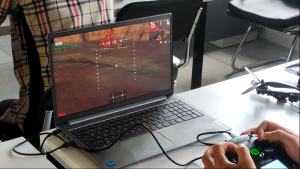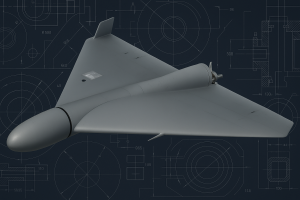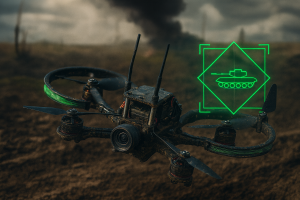What Is a Simulator
A simulator for FPV operators is a software or hardware tool that allows you to practice drone control skills in a virtual environment. It’s a training stage that helps preserve real drones and prevents them from being damaged during early learning on the training ground.
This is especially important because each drone is not just a financial asset — it’s also a vital tool for training those who will destroy enemy equipment and forces.
How Simulators Recreate Real Drone Flight Conditions
Modern simulators recreate the flight physics of FPV drones as accurately as possible. You can feel everything — inertia, speed, weight, aerodynamics. The pilot controls the drone using a transmitter connected to a PC or a game console. The operator sees modeled landscapes and obstacles from the drone’s point of view. Simulators let you customize the drone to your preferences, making the simulation as close to a real flight as possible. There are several types of simulators — some are better suited for training combat pilots, while others are meant just for entertainment. But it’s the first type that interests us.
What Types of Simulators Exist
Today, FPV drone operators mostly train using software simulators. These are special applications installed on a computer or console that let you experience real flight — but in a virtual world. The most popular option among such tools is Liftoff.
VR-compatible simulators offer an even deeper level of immersion. They create a realistic sense of presence — the pilot feels as if they’ve actually “entered” the virtual space. However, VR requires a powerful computer. When it comes to home training, this isn’t always the most convenient option. In that case, classic simulators — the ones that run on a regular monitor and need only a computer and a controller — can be more practical. They’re a comfortable choice for beginners, require fewer resources, yet fully replicate drone control and provide enough experience to transition to real flights.
Which Simulators Are Used in Drone Pilot Training Schools
Training at home is one thing. But professional mastery of drone control is something else entirely — because the quality of such training determines not only the accuracy of strikes, but often also the preservation of the drone and even human lives.
Professional pilot schools and UAV training centers mostly use the following simulator models:
VelociDrone — one of the best options for schools that train FPV pilots for racing. It supports multiplayer mode and features a high-quality aerodynamic model.
In universities and military programs for training UAV operators, simulators such as Unigine Sim, RealFlight, and XFly are used — they allow trainees to learn to operate not only FPV-class drones but also larger unmanned aircraft. These programs have solid instructional foundations, and some even integrate with LMS (learning management systems), which lets instructors track students’ progress.
One of the most effective solutions among the many FPV simulators available in Ukraine has become Liftoff — the most popular simulator among both beginners and professional instructors. The reasons in its favor are its ability to be configured for real-world combat drone conditions across a variety of models, and its very realistic flight physics.
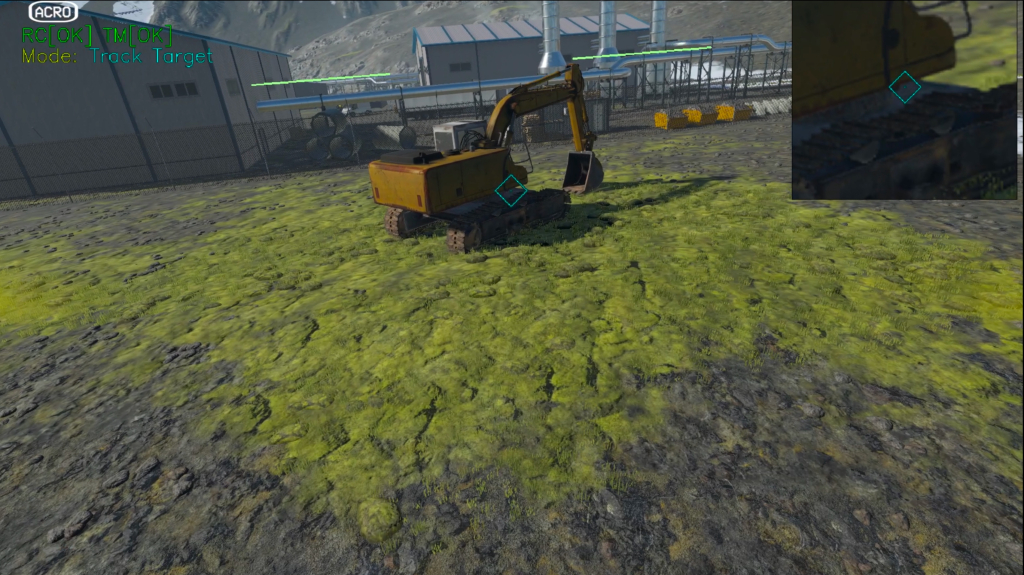
Lately, simulators made in Ukraine are being used more and more. These developments are aimed at military use, so they match the operational purpose most accurately:
FPV Battleground (BAZU)
A realistic simulator with combat scenarios that reproduces FPV drone flight physics, target engagement, and environmental obstacles. The developers created both an open and a military version, focused on training operators under different conditions. It allows training in a variety of scenarios, including the simulation of electronic warfare (EW), use of radio-horizon effects, detailed battery modeling, and more. The simulator uses maps with real heights, so the pilot gets an even more realistic feeling of flying.
Ukrainian Fight Drone Simulator (Simtech Solutions)
An ultra-realistic combat FPV simulator with tactical modes and scenarios, available on Steam. Its primary purpose is to practice combat in a virtual environment as close to reality as possible. It can operate in two modes: “Academy”— ready-made training missions, and “Planner” — which lets you create your own scenarios of varying difficulty and simulate a variety of external factors.
Obriy
A tactical simulator developed from real combat experience. This tool was designed specifically for combat training of pilots. It models flight physics with factors like wind, turbulence, electronic warfare (EW), and radio communications.
Obriy includes over 50,000 km² of combat zones and offers a variety of missions — from strikes to reconnaissance. It is free for military use and paid for training centers. A training center can obtain the simulator upon request. One PC — one licensed copy. Distribution is limited.
It supports custom drone firmware (ArduPilot, Betaflight), OSD configuration, and experimental modules such as targeting systems and AI enhancements. The simulator can also integrate with other systems through the DIS protocol.
Can Drone School Training Be Replaced with Home Practice
Is it possible to replace professional simulator training with home-based models? Using specialized software and powerful equipment — yes, it is.
In many cases, home training is an ideal starting point for those who plan to master professional drone control later on, since high-quality modern simulators provide enough functionality for effective FPV flight training.
Modern specialized simulators provide a realistic understanding of flight. But can they fully replace hands-on training at a real testing ground? It would seem like an ideal solution — saving both time and money. However, it’s not that simple.
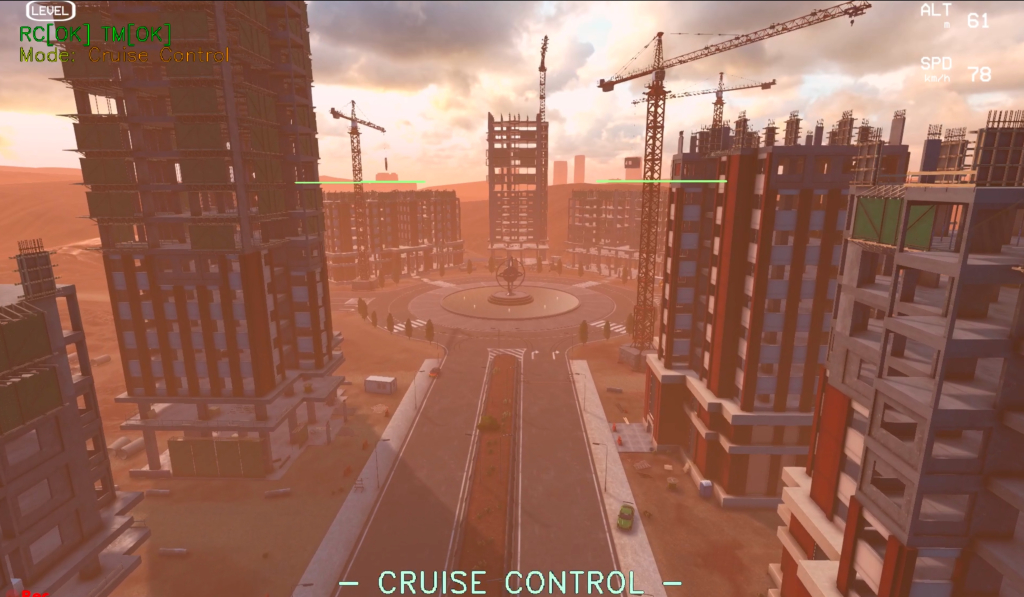
Simulators do have many advantages:
• They allow safe training without the risk of damaging drones or causing accidents.
• They let pilots repeat maneuvers as many times as needed to reinforce skills and correct mistakes — without time limits or battery drain.
• They eliminate expenses for drone repairs, transportation, and battery purchases.
• They’re accessible anytime, regardless of weather conditions.
And these are truly important advantages. But there are also limitations — and they are just as significant. One of the critical factors is the lack of real stress and adrenaline, both of which are unavoidable in combat situations. Real flights are faster and less predictable, and mistakes can be costly. In addition, spatial perception is diminished — even with VR, it’s difficult to feel true depth and actual distance to objects. It’s also harder to account for environmental factors that affect flight: obstacles, electronic warfare (EW), unexpected winds, glare from the sun, or equipment malfunctions.
A Logical Question — Can You Fully Master Flying Through a Simulator
Yes, but with limitations. This can be explained by several key points: a simulator provides a solid technical foundation — control, reaction to maneuvers, and coordination. These skills can be developed to the point of automation.
However, switching to real drones will still require adaptation, especially in terms of visual perception, psychological pressure, and interaction with actual hardware.
The conclusion? Experienced pilots recommend combining simulator training with practice on the training ground using low-power drone models. At the same time, it’s important to choose the right simulator.
How to Choose a Simulator – What to Pay Attention To
The type of simulator used for training has a significant impact on the results. What should you take into account? There are several key factors to consider.
The first is the realism of flight physics. This reflects how accurately the simulator reproduces inertia, gravity, response, and control. Achieving this requires special settings. For example, the previously mentioned LiftOff offers PID tuning, FPV camera adjustments, and drone weight settings.
Equally important is the ability to choose different drone models and to customize them. The more frame types available, the better. And if there’s a function for creating your own drones — even better!
Modern software offers quite an extensive range of features for building maps and environments: landscapes with buildings, trees, obstacles, and open spaces. This helps improve and accelerate the development of flight skills under different conditions. It’s important to have a simulation mode for wind, rain, fog, and time-of-day changes.
Make sure the simulator is compatible with your equipment — check whether your transmitter (controller) works properly with it and how convenient the interface is. See if it’s easy to set up a flight, start, or change maps — this is especially important for beginners.
The price and license aspects shouldn’t be ignored either. A licensed product isn’t always expensive, but it does guarantee reliability. For example, some simulators such as LiftOff or DRL cost about $15–25 — a modest price for a professional-grade trainer.
Recommendations for Different Pilot Levels
Are all simulators the same? Are there any recommendations for choosing simulators based on a pilot’s skill level? Yes, there are.
For beginners and basic training, Liftoff and DRL Simulator are recommended. They offer a simple and intuitive interface, numerous training modes, and helpful prompts. You can gradually master flight — from basic maneuvers to more complex aerobatics. Liftoff allows you to configure the drone for a beginner (using low-sensitivity and auto-stabilization features), which makes starting your training much easier.
For intermediate-level pilots, VelociDrone or advanced use of Liftoff with custom settings is suitable. These simulators allow you to practice high-speed routes — they feature precise physics, flexible camera and PID tuning, drone weight adjustment, and can even simulate video signal lag.
For experienced pilots, VelociDrone, RealFlight, or Unigine Sim are recommended. They make it possible to train in challenging conditions, using wind loads, maneuvers in confined spaces, and system failure simulations. This makes them an excellent choice for preparing for real missions — including participation in combat operations. A similar level of performance can also be achieved with Liftoff.
Why Is the LiftOff Simulator So Popular
LiftOff is one of the most well-known and widely used FPV simulators in the world. Developed by the Belgian studio LuGus Studios in collaboration with leading drone manufacturers, it has become the “gold standard” among pilots who aim to learn to control a drone at home or to prepare effectively for competitions. However, reality has changed — today, LiftOff is actively used not only by beginners but also by professionals to master flight skills for military applications.
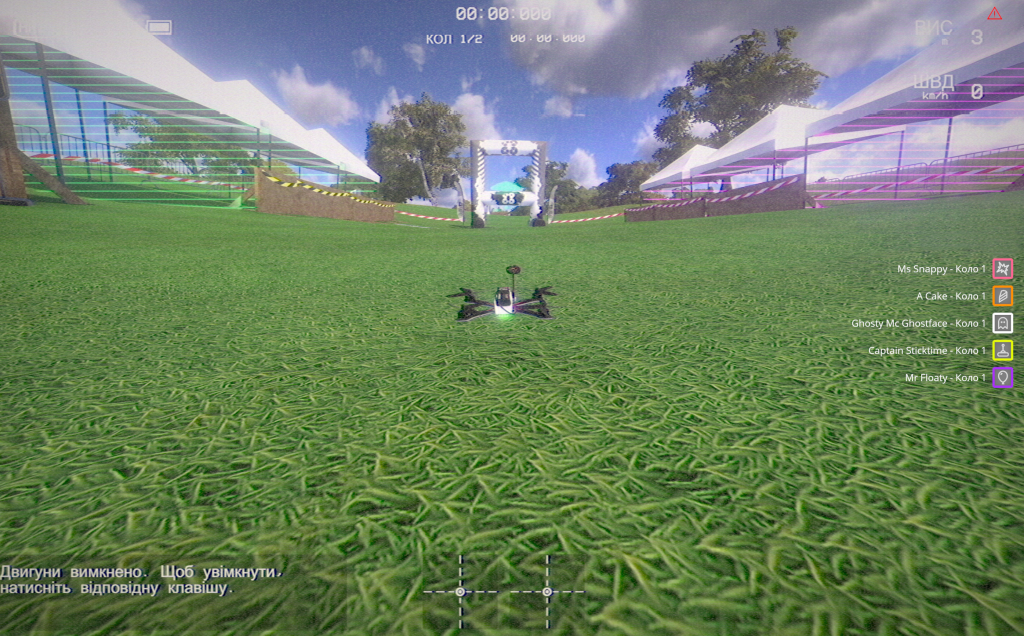
There are several factors. One of the main reasons for the simulator’s popularity is its realistic flight physics, which provides an experience as close to real conditions as possible. The simulator accurately reproduces drone inertia and mass, the effect of gravity, and changes in drone behavior depending on PID settings, thrust, battery weight, and propeller type. It also realistically simulates how the FPV camera responds when the drone tilts.
Thanks to this, the operator develops muscle memory even during training, refining movements to an automatic level — skills that later transfer directly to real flights.
Another important factor is LiftOff’s compatibility with most controllers, which can be connected easily via cable or adapter. This gives the pilot full control over the drone in the simulator, just like in real life.
It also offers the option to customize and build drones — dozens of FPV models are available, and you can change propellers, motors, cameras, and batteries, as well as adjust tilt, weight, and PID regulators. Your chosen configurations can be saved for future use.
There are various maps, locations, and environments available: open spaces, urban landscapes, race tracks, abandoned buildings, and other objects. Users can even upload their own tracks created for specific conditions. This is truly important, as it helps pilots adapt to controlling a drone even before taking it to a real training ground.
LiftOff also allows you to select training modes for pilots of different skill levels (as mentioned earlier — depending on the mode, this simulator can be effectively used by both beginners and professional FPV operators).
And last but not least — the price. It makes LiftOff one of the most affordable FPV simulators with professional-level features.
Can You Master the Tactics of Using Drones with a Guidance System In a Simulator
The term guidance systems is being used more and more in the Ukrainian information space. They have become a powerful solution capable of turning ordinary FPV into a precision weapon. Automatic target tracking and engagement have significantly enhanced the capabilities of unmanned aerial vehicles. Is it possible to master controlling drones equipped with the VGI-9 guidance system using simulators?
Answer — yes, and more: it’s one of the most effective ways to train, especially using the VGI-9 system in the LiftOff simulator.
The developers of the VGI-9 system have created their own plugin that fully integrates the guidance system into LiftOff. That means operators can learn and train in a virtual environment using drone models equipped with realistic guidance-system behavior. The plugin allows you to practice:
- the specific operation of Cruise Control, which is responsible for stabilizing flight when a target is acquired;
- the target-acquisition algorithm, including the moment of object identification and its continuous tracking;
- muscle memory — converting repeated actions on the simulator controller into automatic responses on the battlefield.
LiftOff with the VGI-9 plugin enables a variety of scenarios that closely reproduce real conditions of drone employment, including work with static and dynamic targets, flights at different angles of inclination and at various ranges and distances. It is also possible to practice non-standard (emergency) situations that require the pilot’s immediate, no-delay reaction. Using the plugin you can master the skills of activating the VGI-9 system in complex environments, taking obstacles into account.
All of this leads to developing in the operator not just mechanical skills but an understanding of how to correctly bring the system into operation and how it will behave under different conditions and circumstances.
How We Came to Create Our Own VGI Plugin/Trainer
Creating an effective guidance system is only half the job. It won’t deliver results if operators don’t know how to use it or if mastering the new skills takes too long. A pilot must be able to work with the system competently and efficiently under combat conditions.
The first attempt was training solely on live ranges. But almost immediately problems appeared — a lot of time was spent acquiring basic skills, pilots lacked the muscle memory to automate actions, and every mistake meant the risk of losing a drone and extra instructor time.
This became the motivation to create a trainer that would help eliminate these problems. The choice fell on LiftOff — the most flexible platform with realistic flight physics. A VGI-9 plugin was developed to simulate the operation of a drone equipped with a guidance system. Testing of the plugin was first conducted within the development team and later with partner instructors. The results confirmed: after simulator training, pilots perform more confidently on the training ground, and the number of mistakes significantly decreases.
How Drone Guidance Systems Redefine the Battlefield — dive into the mechanics of optical tracking, cruise-control algorithms, and real-time target acquisition that make systems like VGI-9 a game-changer. Explore the full breakdown on our blog.
Today, the trainer is distributed free of charge among flight schools, training centers, and units. It has become an essential part of pilot education, helping operators prepare for working with the guidance system even before their first real takeoff.
Why You Should Train for Flights in a Simulator with VGI-9
The VGI-9 team emphasizes that training in the LiftOff simulator with an integrated guidance system provides pilots with several important advantages:
- Reduces the number of mistakes during real flights on the training ground and later during combat missions;
- Saves drone resources, which is especially important for expensive FPV models;
- Shortens the training period while making it more efficient;
- Improves safety and simplifies supervision of the training process;
- Prepares operators for non-standard or emergency situations.
Important! The VGI-9 plugin is provided free of charge to training schools and centers, instructors, and pilots preparing for the practical use of the VGI-9 system.
What do you need for training?
To begin, all you need is a computer, a controller, and the motivation to practice.
The simulator with the integrated VGI-9 system is already a fully functional platform for the professional training of FPV pilots, and it is increasingly being used in Ukrainian flight schools. This approach not only allows students to master drone control techniques but also to operate the guidance system effectively, including under combat or tactical conditions.
How Can Schools Obtain the VGI-9 Trainer or Drones with the Installed System
The integration of the VGI-9 guidance system into the training process has become a major step toward improving the quality of FPV pilot education. The developers have not only created an effective simulator — they have also made it freely accessible to educational and military institutions.
This means that training centers can obtain the simulator free of charge.
So how does it work?
How Schools Can Get Access to the Plugin and Training Kits
The VGI-9 trainer was created as a plugin for LiftOff, one of the most popular tools for FPV flight training. It is distributed completely free of charge. This is a principled position of the developers — the initiative is non-commercial and is part of a mission to spread modern technologies and improve the quality of pilot training, especially in a military context. Who can get access to the training materials? These are:
- UAV training centers;
- Military units that operate FPV drones;
- Drone schools;
- Instructors who prepare pilots for combat or tactical use of drones.
Joining the training program is simple — you just need to contact the VGI-9 development team with an appropriate request (for example, via email or a contact form on their website). If the request meets the requirements, a complete set of training materials is provided, including:
- The VGI-9 plugin for LiftOff;
- Text and video instructions for installation and use;
- Methodological materials for instructors;
- Training scenarios for different skill levels;
- And, when possible, training FPV drones equipped with the VGI system for practical exercises on the training ground.
When submitting a request, specify the training format, the number of pilots, and the available equipment. The developers also provide consultations and assist with the integration of the simulator into the training process, supporting the existing programs already used by the training center.
The Process of Integrating the VGI Plugin or Module into Training Simulators
The plugin can be installed on a regular computer that has access to LiftOff. After activating VGI-9, pilots can use special training modes that simulate the operation of the guidance system in real time.
Why is This Important
Guidance systems are already installed on drones used in the war in Ukraine. Their numbers are growing, and the plan is to bring their presence to 100%, maximizing the effectiveness of UAVs. These drones must be flown correctly! The earlier a pilot begins working with the VGI system, the better they understand its logic and the more effectively they can employ it in real conditions. This is a crucial point for combat effectiveness.
Is the VGI Plugin Sufficient to Learn to Pilot Drones with a Guidance System
The VGI-9 plugin is an essential first step. It helps pilots gain confidence and reduces risks during the early stages of training. But even the best simulator cannot replace a training range and real flight conditions, where pilots face factors that are impossible or very difficult to model in a virtual environment, such as:
- loss of video signal beyond the radio horizon;
- the effects of electronic warfare (EW);
- natural obstacles in complex terrain;
- searching for camouflaged targets in a real environment;
- sudden changes in weather.
Training on a range builds the necessary stress resilience, trains dynamic thinking, and teaches instinctive reactions to abnormal situations. A simulator does not replace the range — it is an important step on the way to it.
How to Join the VGI-9 Guidance-System Drone Course
As part of the VGI-9 project and in partnership with the SKY PILOTS training centre, the training course is open to military specialists, FPV-drone operators, and representatives of training centres.
The course consists of a three-day programme that covers three key stages of training.
Contact us to get detailed information about the VGI-9 drone guidance system.
Follow our updates on social media and YouTube – there you will find:
✅ Exclusive materials on the development, testing, and combat use.
✅ Useful analytical content on the war and the role of FPV drones in modern combat operations.
✅ The latest news and insights from the world of military technologies.F
📌 Join us:
🔗 YouTube: VGI-9 on YouTube
📸 Instagram: We are on Instagram
🎯 TikTok: We are on TikTok




